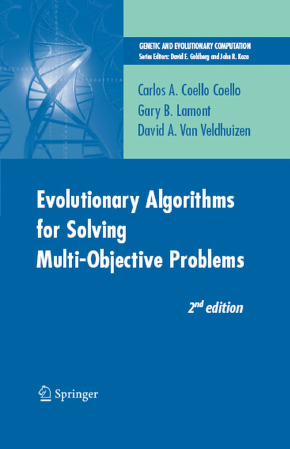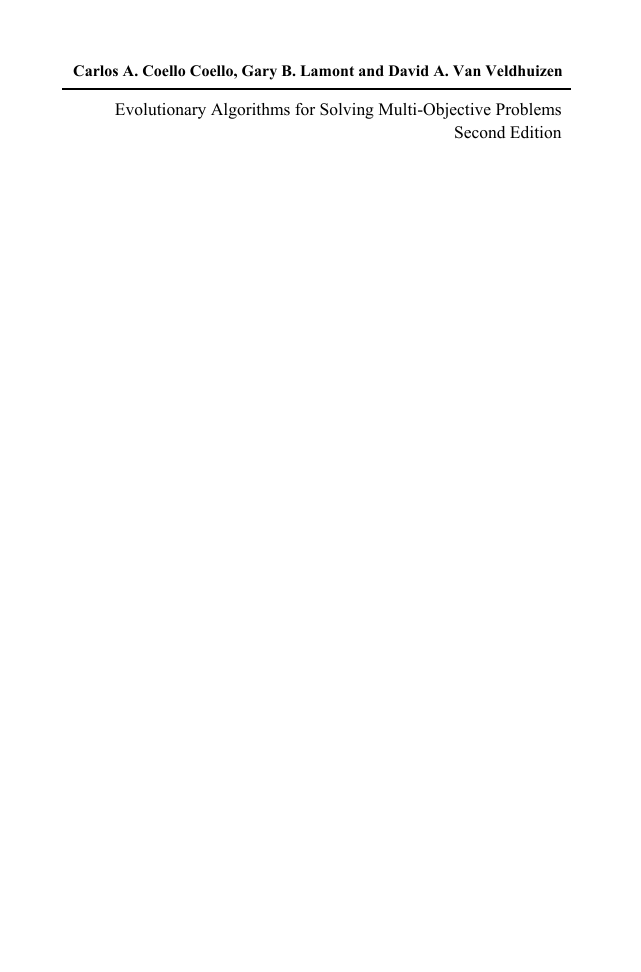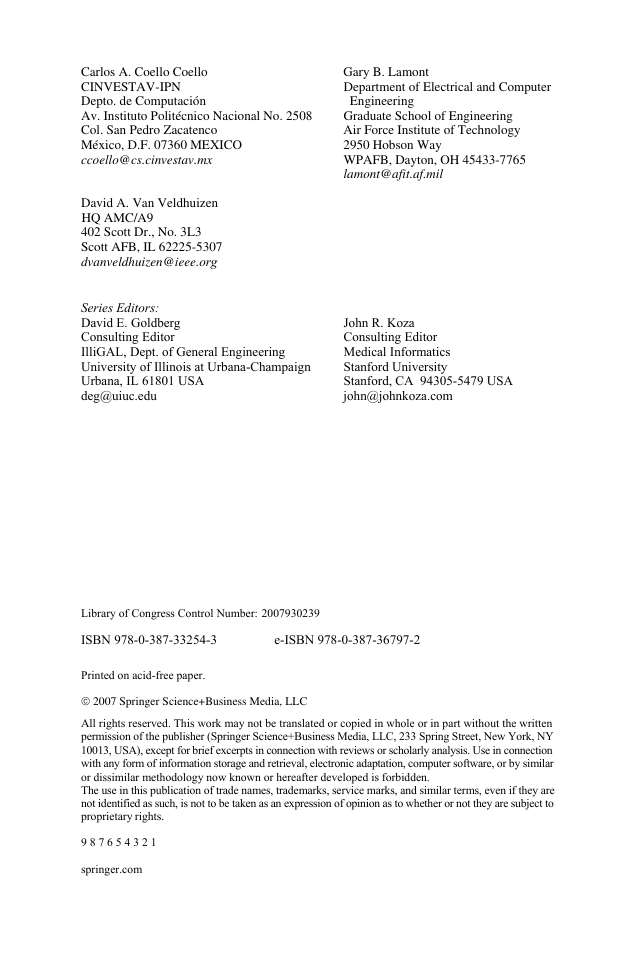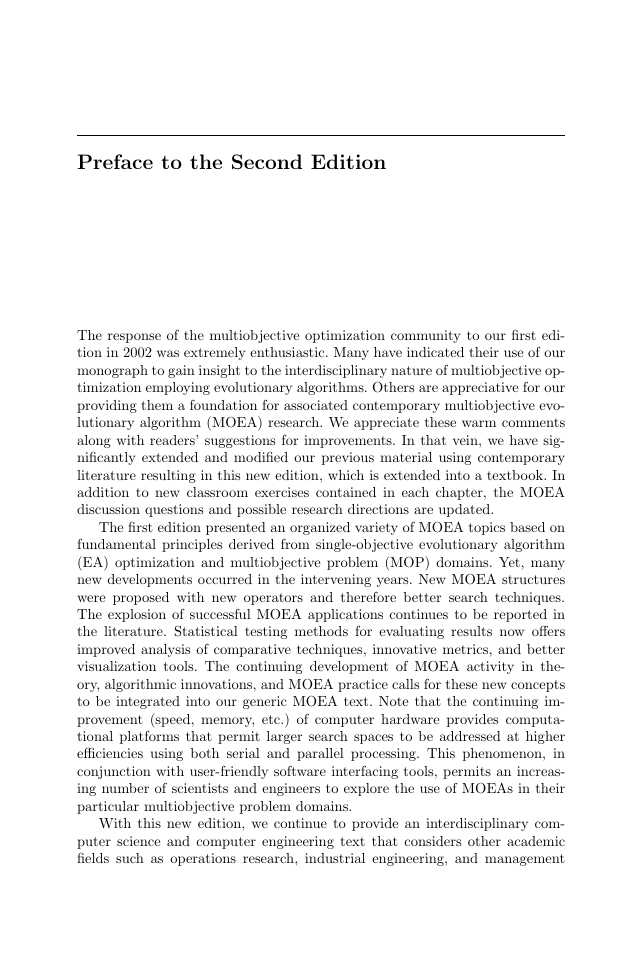�
Carlos A. Coello Coello, Gary B. Lamont and David A. Van Veldhuizen
Evolutionary Algorithms for Solving Multi-Objective Problems
Second Edition
Genetic and Evolutionary Computation Series
Series Editors
David E. Goldberg
Consulting Editor
IlliGAL, Dept. of General Engineering
University of Illinois at Urbana-Champaign
Urbana, IL 61801 USA
Email: deg@uiuc.edu
John R. Koza
Consulting Editor
Medical Informatics
Stanford University
Stanford, CA 94305-5479 USA
Email: john@johnkoza.com
Selected titles from this series:
Markus Brameier, Wolfgang Banzhaf
Linear Genetic Programming, 2007
ISBN 978-0-387-31029-9
Nikolay Y. Nikolaev, Hitoshi Iba
Adaptive Learning of Polynomial Networks, 2006
ISBN 978-0-387-31239-2
Tetsuya Higuchi, Yong Liu, Xin Yao
Evolvable Hardware, 2006
ISBN 978-0-387-24386-3
David E. Goldberg
The Design of Innovation: Lessons from and for Competent Genetic Algorithms, 2002
ISBN 978-1-4020-7098-3
John R. Koza, Martin A. Keane, Matthew J. Streeter, William Mydlowec, Jessen Yu, Guido Lanza
Genetic Programming IV: Routine Human-Computer Machine Intelligence
ISBN: 978-1-4020-7446-2 (hardcover), 2003; ISBN: 978-0-387-25067-0 (softcover), 2005
Carlos A. Coello Coello, David A. Van Veldhuizen, Gary B. Lamont
Evolutionary Algorithms for
Solving Multi-Objective Problems, 2002
ISBN: 978-0-306-
46762-2
Lee Spector
Automatic Quantum Computer Programming: A Genetic Programming Approach
ISBN: 978-1-4020-789
William B. Langdon
Genetic Programming and D
Programming! 1998
ISBN: 978-0-7923-8135-8
For a complete listing of books in this series, go to http://www.springer.com
ata Structures: Genetic Programming + Data Structures = Automatic
4-1 (hardcover), 2004; ISBN 978-0-387-36496-4 (softcover), 2007
�
Carlos A. Coello Coello
Gary B. Lamont
David A. Van Veldhuizen
Evolutionary Algorithms
for Solving
Multi-Objective Problems
Second Edition
�
Carlos A. Coello Coello
CINVESTAV-IPN
Depto. de Computación
Av. Instituto Politécnico Nacional No. 2508
Col. San Pedro Zacatenco
México, D.F. 07360 MEXICO
ccoello@cs.cinvestav.mx
Gary B. Lamont
Department of Electrical and Computer
Engineering
Graduate School of Engineering
Air Force Institute of Technology
2950 Hobson Way
WPAFB, Dayton, OH 45433-7765
lamont@afit.af.mil
David A. Van Veldhuizen
QHQ AMC/A9
402 Scott Dr., No. 3L3
Scott AFB, IL 62225-5307
dvanveldhuizen@jieee.orrgr
Series Editors:
David E. Goldberg
Consulting Editor
IlliGAL, Dept. of General Engineering
University of Illinois at Urbana-Champaign
Urbana, IL 61801 USA
deg@uiuc.edu
John R. Koza
Consulting Editor
Medical Informatics
Stanford University
Stanford, CA 94305-5479 USA
john@johnkoza.com
Library of Congress Control Number: 2007930239
ISBN 978-0-387-33254-3
e-ISBN 978-0-387-36797-2
Printed on acid-free paper.
© 2007 Springer Science+Business Media, LLC
All rights reserved. This work may not be translated or copied in whole or in part without the written
permission of the publisher (Springer Science+Business Media, LLC, 233 Spring Street, New York, NY
10013, USA), except for brief excerpts in connection with reviews or scholarly analysis. Use in connection
with any form of information storage and retrieval, electronic adaptation, computer software, or by similar
or dissimilar methodology now known or hereafter developed is forbidden.
The use in this publication of trade names, trademarks, service marks, and similar terms, even if they are
not identified as such, is not to be taken as an expression of opinion as to whether or not they are subject to
proprietary rights.
9 8 7 6 5 4 3 2 1
springer.com
g
r
g
r
g
r
g
�
to our wives
�
Preface to the Second Edition
The response of the multiobjective optimization community to our first edi-
tion in 2002 was extremely enthusiastic. Many have indicated their use of our
monograph to gain insight to the interdisciplinary nature of multiobjective op-
timization employing evolutionary algorithms. Others are appreciative for our
providing them a foundation for associated contemporary multiobjective evo-
lutionary algorithm (MOEA) research. We appreciate these warm comments
along with readers’ suggestions for improvements. In that vein, we have sig-
nificantly extended and modified our previous material using contemporary
literature resulting in this new edition, which is extended into a textbook. In
addition to new classroom exercises contained in each chapter, the MOEA
discussion questions and possible research directions are updated.
The first edition presented an organized variety of MOEA topics based on
fundamental principles derived from single-objective evolutionary algorithm
(EA) optimization and multiobjective problem (MOP) domains. Yet, many
new developments occurred in the intervening years. New MOEA structures
were proposed with new operators and therefore better search techniques.
The explosion of successful MOEA applications continues to be reported in
the literature. Statistical testing methods for evaluating results now offers
improved analysis of comparative techniques, innovative metrics, and better
visualization tools. The continuing development of MOEA activity in the-
ory, algorithmic innovations, and MOEA practice calls for these new concepts
to be integrated into our generic MOEA text. Note that the continuing im-
provement (speed, memory, etc.) of computer hardware provides computa-
tional platforms that permit larger search spaces to be addressed at higher
efficiencies using both serial and parallel processing. This phenomenon, in
conjunction with user-friendly software interfacing tools, permits an increas-
ing number of scientists and engineers to explore the use of MOEAs in their
particular multiobjective problem domains.
With this new edition, we continue to provide an interdisciplinary com-
puter science and computer engineering text that considers other academic
fields such as operations research, industrial engineering, and management
�
VIII
Preface to the Second Edition
state-of-the-art concepts and discussions of open research topics.
science. Examples from all these disciplines, as well as all engineering areas
in general, are discussed and addressed as to their fundamental unique prob-
lem domain characteristics and their solutions using MOEAs. An expanded
reference list is included with suggestions of further reading for both the stu-
dent and practitioner. As in the previous edition, this book addresses MOEA
development and applications issues through the following features:
• The text is meant to be both a textbook and a self-contained reference.
The book provides all the necessary elements to guide a newcomer in the
design, implementation, validation, and application of MOEAs in either
the classroom or the field.
• Researchers in the field benefit from the book’s comprehensive review of
• The book is also written for graduate students in computer science, com-
puter engineering, operations research, management science, and other
scientific and engineering disciplines, who are interested in multiobjective
optimization using evolutionary algorithms.
• The book is also for professionals interested in developing practical applica-
tions of evolutionary algorithms to real-world multiobjective optimization
problems.
• Each chapter is complemented by discussion questions and several ideas
meant to trigger novel research paths. Supplementary reading is strongly
suggested for deepening MOEA understanding.
• Key features include MOEA classifications and explanations, MOEA ap-
plications and techniques, MOEA test function suites, and MOEA perfor-
mance measurements.
• We created a website for this book at:
http://www.cs.cinvestav.mx/~emoobook
which contains considerable material supporting this second edition. This
site contains all the appendices of the book (which have been removed
from the original monograph due to space limitations), as well as public-
domain software, tutorial slides, and additional sources of contemporary
MOEA information.
This new synergistic text is markedly improved from the first edition. New
material is integrated providing more detail, which leads to a realignment of
material. Old chapters were modified and a new one was added. As before,
the various features of MOEAs continue to be discussed in an innovative
and unique fashion, with detailed customized forms suggested for a variety
of applications. The flow of material in each chapter is intended to present
a natural and comprehensive development of MOEAs from basic concepts to
complex applications.
Chapter 1 presents and motivates MOP and MOEA terminology and the
nomenclature used in successive chapters including a lengthy discussion on the
�
















 2023年江西萍乡中考道德与法治真题及答案.doc
2023年江西萍乡中考道德与法治真题及答案.doc 2012年重庆南川中考生物真题及答案.doc
2012年重庆南川中考生物真题及答案.doc 2013年江西师范大学地理学综合及文艺理论基础考研真题.doc
2013年江西师范大学地理学综合及文艺理论基础考研真题.doc 2020年四川甘孜小升初语文真题及答案I卷.doc
2020年四川甘孜小升初语文真题及答案I卷.doc 2020年注册岩土工程师专业基础考试真题及答案.doc
2020年注册岩土工程师专业基础考试真题及答案.doc 2023-2024学年福建省厦门市九年级上学期数学月考试题及答案.doc
2023-2024学年福建省厦门市九年级上学期数学月考试题及答案.doc 2021-2022学年辽宁省沈阳市大东区九年级上学期语文期末试题及答案.doc
2021-2022学年辽宁省沈阳市大东区九年级上学期语文期末试题及答案.doc 2022-2023学年北京东城区初三第一学期物理期末试卷及答案.doc
2022-2023学年北京东城区初三第一学期物理期末试卷及答案.doc 2018上半年江西教师资格初中地理学科知识与教学能力真题及答案.doc
2018上半年江西教师资格初中地理学科知识与教学能力真题及答案.doc 2012年河北国家公务员申论考试真题及答案-省级.doc
2012年河北国家公务员申论考试真题及答案-省级.doc 2020-2021学年江苏省扬州市江都区邵樊片九年级上学期数学第一次质量检测试题及答案.doc
2020-2021学年江苏省扬州市江都区邵樊片九年级上学期数学第一次质量检测试题及答案.doc 2022下半年黑龙江教师资格证中学综合素质真题及答案.doc
2022下半年黑龙江教师资格证中学综合素质真题及答案.doc